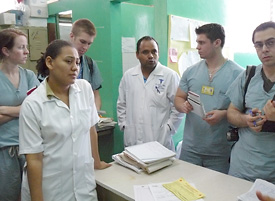After researching more than 600 health-related technologies and traveling to Nicaragua to observe medical care there, U-M graduate students have identified five keys to developing sustainable health technologies in resource-limited settings such as developing nations.
In an unconventional new Design for Global Health course, the students spent last semester researching best practices in low-cost technologies for diagnosis, treatment and prevention of the top 10 causes of death in low- and middle-income countries. Each week, the class focused on a different topic in global health, including respiratory disease, coronary heart disease, malaria, tuberculosis and HIV/AIDS. They compiled their most promising findings in technology case studies that soon will be published by the U-M Center for Global Health and the World Health Organization (WHO).

U-M students interview Dr. Osman Palma (center), director of the Alfonso Moncada Guillen Hospital Amigo de la Niñez y de la Madre, located in Ocotal, Nicaragua. Photo courtesy Kathleen Sienko.
“Through their work, these students created new knowledge that is very valuable outside the classroom,” says Kathleen Sienko, an assistant professor of mechanical engineering who developed and taught the course.
Tejkaran Gill, a mechanical engineering graduate student from the class, is currently working at WHO headquarters in Geneva, Switzerland, where he is developing a database for the technology case studies.
“There is no other database where prospective designers for global health can check how others have fared with similar and diverse challenges,” says Sofia Merajver, director of the Center for Global Health and a professor of internal medicine in the U-M Health System. “Professor Sienko’s collaboration with the Center for Global Health and the World Health Organization will make possible this open resource, a major advance in the field of technologies for health.”
The five successful engineering strategies the students identified are:
• Keep it simple. The students observed that modest technologies, such as those with few moving parts, have fared better in the developing world than more sophisticated designs.
• Harness cell phones. As cell phone networks grow in prevalence and power, so does their potential for enabling health solutions in resource-limited settings.
• Teach. Some of the most sustainable implementations have been educational initiatives, such as a necklace with colored beads that helps a woman keep track of her menstrual cycle for family planning purposes.
• Get out there. Taking healthcare out of clinics and into the community is a tactic of many successful programs.
• Look to nature. Exemplifying this strategy is the Moringa vegetable tree, an important crop in the fight against malnutrition and vitamin A deficiency. The leaves can be eaten cooked, as a dried powder, or fresh from the branch. A hardy and drought-resistant plant, Moringa seeds can be introduced into many areas worldwide as a locally cultivated and sustainable tool to combat hunger.
Sienko has observed that a common stumbling point for global health technologies is a lack of understanding by design engineers of the setting in which their technology will be used. The case study database developed by her class is an effort to aid in overcoming this problem.
“The design and development of health-related technologies for resource-limited settings requires a detailed consideration of the end user and target community that goes beyond the traditional engineering design needs assessment,” Sienko says. “In a broader sense, economic, social and cultural constraints must be considered for successful implementation of technologies.”
The World Health Organization says this database will be valuable.
“We are very grateful for the support provided by the University of Michigan in the compilation of information on medical devices for global health concerns, which is very needed, particularly by developing countries,” says Adriana Velazquez Berumen, coordinator of diagnostic imaging and medical devices at WHO.

